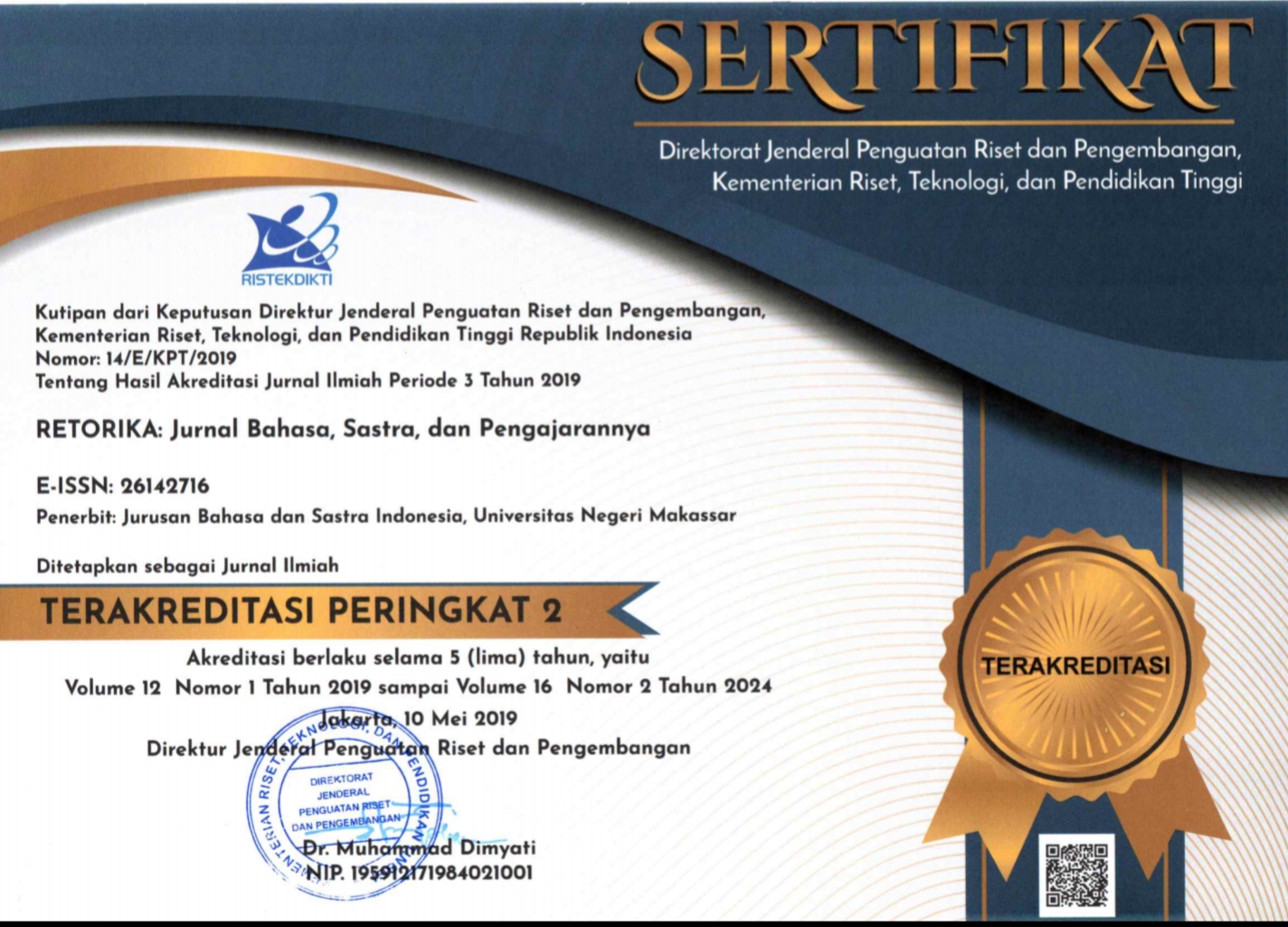MORPHOLOGY OF FOLKLORE BATU NAGA LAMPUNG
(1) Universitas Sebelas Maret, Surakarta
(2)
(3)
(*) Corresponding Author
DOI: https://doi.org/10.26858/retorika.v13i1.10083
Abstract
The purpose of this study was to analyze the morphology of folklore based on Vladimir Propp's theory and method of researching Narratology structure including the structure of the actor's action function, the function in the action environment, and the scheme. This research method is descriptive qualitative and the method developed by Vladimir Propp. The object of research is the Batu Naga Lampung folklore. The technique of data collection is done by the documentation technique through a literature study. Data analysis techniques use the flow method that is data reduction, data presentation, and concluding. The results of the study found there are 26 functions of the perpetrators' actions that are distributed into 6 action environments.
Keywords
Full Text:
PDFReferences
Abrams, M.H. 2009. A. Glossary of Literary Terms. Ninth Edition. USA: Wadsworth Cengage Learning.
Alaini, N. N. 2014. Struktur Naratif Cerita Rakyat Sumbawa Barat. Jurnal Atavisme. 17 (2), 240-253. Doi:http://dx.doi.org/10.24257/atavisme.v17i2.13.240-253
Anderson, G. 2006. Greek and Roman Folklore. USA: Greenwood Press.
Bal, M. 1999. Narratology: Introduction to the Theory of Narrative. 2nd Editor Toronnto: Toronto University Press.
Embram, E.R. 2016. Morfologi Cerita Rakyat Malind Anim Kanume. Jurnal Kadera Bahasa, 8(1):123-131.
Doi:https://doi.org/10.26499/kc.v12i2.184
Endraswara, S. 2013. Folklor Nusantara: Hakikat, Bentuk, dan Fungsi. Yogyakarta: Penerbit Ombak.
Eriyanto. 2013. Analisis Naratif: Dasar-dasar dan Penerapannya dalam Analisis Teks Berita Media. Jakarta: PT Fajar Interpratama Mandiri.
Gayatri, S. 2009. Struktur Naratif Cerita Anggun Nan Tongga: Pendekatan Vladimir Propp. Jurnal Linguistika Kultura, 3(1): 46-55.
Doi:https://doi.org/10.26499/kaba.v8i1.25
Hakim, Z. 2015. Morfologi Cerita Ratu Ular: Model Analisis Vladimir Propp. Jurnal Sawerigading. 21 (3): 519-527 Doi:http://dx.doi.org/10.26499/sawer.v21i3.101
. 2018. “Struktur dan Nilai-Nilai Kultural Cerita Randa Wula’a.” Jurnal Sawerigading, 21(1): 11-20.
Doi:http://dx.doi.org/10.26499/sawer.v24i1.253
Hasan, N.H. 2018. Cerita Rakyat Nenek Luhu: Tinjauan Vladimir Propp. Jurnal Metasastra, 11(2): 131-144.
Doi:http://dx.doi.org/10.26610/metasastra.2018.v11i2.131-144
Haviland, W A. 1988. Anthropology: Jilid 2. Pen. R.G. Soekadijo. Jakarta: Erlangga.
Lestari, U.F.R. 2015. Morfologi Cerita Rakyat Arso Watuwe: Sebuah Analisis Naratologi Vladimir Prop. Jurnal Metasastra, 8(1): 139-154. Doi:http://dx.doi.org/10.26610/metasastra.2015.v8i1.139-154
Maneerat. J. and Wilailak O. 2012. Folklore, Restoration of Social Capital and Community Culture. Procedia-Social and Behavioral Science, 65: 218-224
Doi: 10.1016/j.sbspro.2012.11.114.
Maulina, Y. 2014. Cerita Rakyat “Asal-Usul Pulau Halang”: Analisis Fungsi Vladimir Propp. Jurnal Madah, 5(1):105-114. Doi:http://dx.doi.org/10.31503/madah.v5i1.528
Miles, B. M dan Michael, H. 2014. Analisis Data Kualitatif: Buku Sumber Tentang Metode-metode Baru. Diterjemahkan oleh Tjetjep Rohendi Rohidi. Jakarta: Universitas Indonesia Press.
Propp, V. 1968. Morphology of Folktales. Austin and London: University of Texas Press.
Putra, N.R.A dan Sri, W. 2017. “Analisis Cerita Rakyat Jaka Tingkir: Kajian Struktural Naratif Vladimir Propp.” CARAKA: Jurnal Ilmiah Kebahasaan, Kesastraan dan Pemelajarannya,4(1): 122-129.
Ratna, N.K. 2015. Teori, Metode, dan Teknik Penelitian Sastra. Yogyakarta: Pustaka Pelajar.
Rokmansyah, A. 2014. Studi dan Pengkajian Sastra: Perkenalan Awal terhadap Ilmu Sastra. Yogyakarta: Graha Ilmu.
Sarwono, S.W. 2016. Psikologi Lintas Budaya. Jakarta: PT Raja Grafindo Persada.
Sehandi, Y. 2014. Mengenal 25 Teori Sastra. Yogyakarta: Penerbit Ombak.
Sriyono. (2014). Morfologi sastra lisan tobati.
Sugiyono. 2014. Memahami Penelitian Kualitatif. Bandung: Alfabeta.
Susanto. D. 2012. Pengantar Teori Sastra: Dasar-dasar Memahami Fenomena Kesusastraan, Psikokologi Sastra, Strukturalisme, Formalisme Rusia, Marxisme, Interpretasi dan Pembaca, dan Pascastrukturalisme. Jakarta: Caps.
Suwarno, Kundharu, S & Nugraheni, E.W. 2018. Sejarah, Unsur Kebudayaan, dan Nilai Pendidikan Karakter dalam Legenda Sungai Naga. Jurnal Retorika, 11(2):194-2014. Doi:https://doi.org/10.26858/retorika.v11i2.5972
Widiati, N & Bambang, I. 2018. Narrative Structure of Babad Cirebon: Vladimir Prpp Analysis. Jurnal Seloka: Jurnal Pendidikan Bahasa dan Sastra Indoneisa, 7(1):67:76.
Doi:https://doi.org/10.15294/seloka.v7i1.17602
Article Metrics
Abstract view : 687 times | PDF view : 94 timesRefbacks
- There are currently no refbacks.
Copyright (c) 2020 sri nur sari

This work is licensed under a Creative Commons Attribution-NonCommercial 4.0 International License.
Published by:
Department of Indonesian Language, Faculty of Languages and Literature, Universitas Negeri Makassar in cooperate with Asosiasi Dosen Bahasa dan Sastra Indonesia (ADOBSI) and Ikatan Program Studi Pendidikan Bahasa dan Sastra Indonesia (IKAPROBSI).
Address: Department of Indonesian Language Office, DG Building Second Floor, UNM Parangtambung, Daeng Tata Raya Street, Makassar, South Sulawesi, Indonesia
 Email: retorika@unm.ac.id
Email: retorika@unm.ac.id

RETORIKA: Jurnal Bahasa, Sastra,dan Pengajarannya is licensed under a Creative Commons Attribution-NonCommercial 4.0 International License.
















